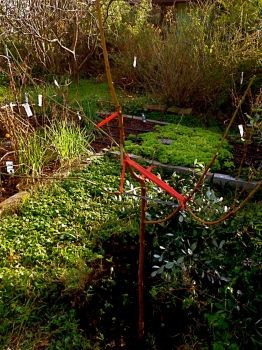 Once you have planted a fruit tree, it is useful to train the young plant to form a strong tree that will hold a lot of fruit. Once the tree has aged a year or more, it is important to do at least yearly pruning to develop a long-lived productive tree with minimal problems.
Once you have planted a fruit tree, it is useful to train the young plant to form a strong tree that will hold a lot of fruit. Once the tree has aged a year or more, it is important to do at least yearly pruning to develop a long-lived productive tree with minimal problems.
Doing this is not very time-consuming for each tree, but it requires knowledge that is not easily guessed except in a few easy cases such as citrus and figs. Pruning fruit trees is something like sculpting or cutting hair: It requires skill with good-cutting tools, a vision of what is needed and an ability to adjust the vision to the particular case. And like, sculpting and haircutting, the more one practices, the faster one can work without error.
These days, the web has huge numbers of pamphlets and videos explaining how to "prune fruit trees," "prune apples," "train young apples," "prune mangoes" and so forth. A gardener with time and interest can learn essentially all the basic ideas from these invaluable resources.
There are a few places where such a search can lead southeast Texas residents to failure. In the south, we have longer warm seasons and shorter winters, so trees grow more during the summer than they do in Washington State, so pruning techniques that work there may require excessive maintenance here or produce short-lived trees.
Also, much of the information is directed at commercial production. The homeowner probably doesn't have a cherry-picker truck to reach heights, may have squirrels to deal with, and can make do with "only" 200 peaches, so doesn't need time-consuming techniques that increase production 20 percent. So taking local fruit-tree pruning classes such as the ones I teach through Urban Harvest can help.
Fruit bushes such as blueberries, feijoas and pomegranates; and fruit vines such as grapes, kiwis and passion fruits have their own, somewhat analogous training and pruning methods, but I want to focus on homeowner fruit tree pruning, especially the establishment of a strong tree.
With a newly planted tree, develop a strong scaffold of branches well spaced around the tree with enough space between branches for sunlight to hit all branches for many hours. In practice, the goal is to have three to five branches come out from the trunk about 2 feet or more above the soil. The branches should leave the trunk at right angles, and once they are a few inches from the trunk, head upward at a 45-60 degree angle with the horizontal. This is done using toothpicks, clothespins, weights, limb-spreaders, or other devices to accomplish the goal (see millernurseries.com, starkbrothers.com).
Branches that come off the main trunk are called "primary scaffold branches." Once they get about a yard (24-40 inches) out from the trunk, pinch or cut the branch to divide the primary into two 45-60 degree upward heading "secondary scaffold branches." And when these get a yard or so further out, you pinch them again to get two "tertiary scaffold branches." Four primary branches around the trunk at 2 feet thus become 16 tertiary branches reaching 4-6 feet off the ground.
After the trunk grows another 3 feet above the original 2 feet, a second tier of main scaffold branches is selected and the process is repeated, and after another 3 feet, a third tier is added. When trunk and branches get about as high as they can be picked and pruned with a safe ladder, a yearly pruning is necessary to suppress upward grown and to prune weak side shoots.
With a scaffold in place, the next concern is fruiting wood. Some trees fruit on last year's new wood, and others on older wood. Each year, the tree needs to be pruned to safeguard this year's crops while pruning to grow wood for future production.
Urban Harvest’s pruning classes that run January – middle of February are all full, however, one might connect with the Harris County Masters Gardeners at Bear Creek Park to see if there are pruning classes available.
This column is produced by Urban Harvest. Learn about gardening classes, community gardens and orchards, farmers markets and more at Urban Harvest website. Article is written by Bob Randall, Ph.D., who is the former executive director and a cofounder of Urban Harvest. He is also the author of "Year Round Vegetables, Fruits and Flowers for Metro-Houston". You may contact at YearRoundGardening@comcast.net.